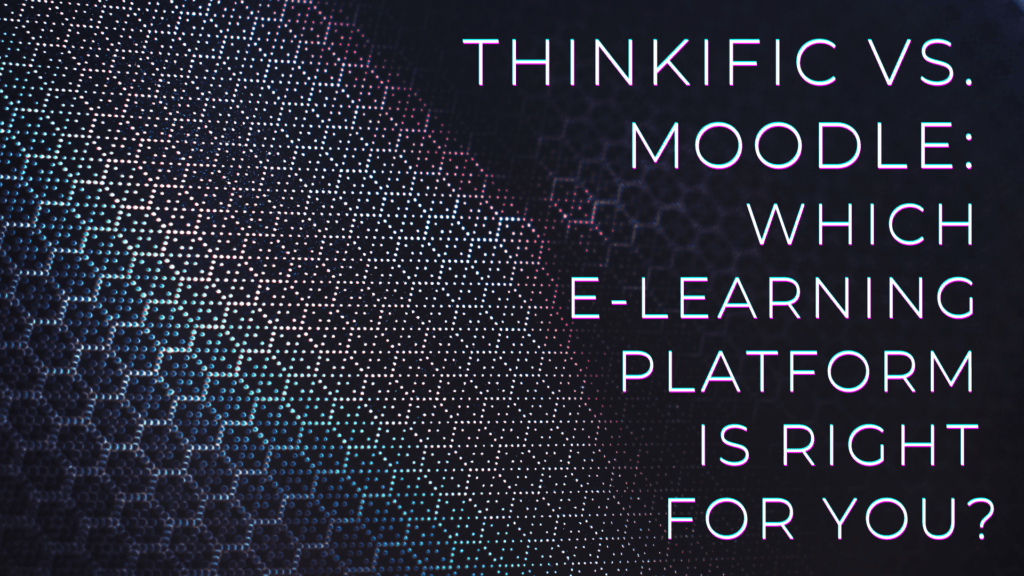Welcome to our article, where we’ll compare two of the most popular e-learning platforms: Thinkific and Moodle. As online learning continues to grow in popularity, more and more educators are turning to e-learning platforms to create and deliver their courses. While many e-learning platforms are available, Thinkific and Moodle are two of the most well-known and widely used.
Thinkific is a cloud-based e-learning platform that provides everything you need to create, market, and sell your online courses. It’s an all-in-one solution that allows you to create, design, and launch your course quickly and easily. On the other hand, Moodle is an open-source learning management system (LMS) designed for educators to create and manage online courses.
This article will discuss the similarities and differences between these two e-learning platforms. We’ll look at their features, the user interface, pricing, support, and resources available. By the end of this article, you’ll better understand which platform may be best suited for your needs. So, whether you’re a teacher, trainer, or course creator, keep reading to learn about Thinkific and Moodle.
Thinkific vs. Moodle: Features
One of the most important factors to consider when choosing an e-learning platform is the features it offers. Here’s a breakdown of the key features offered by Thinkific and Moodle:
Course creation tools
Thinkific and Moodle provide users with tools to create and manage their courses. Thinkific’s user-friendly drag-and-drop course builder allows you to create multimedia-rich content quickly and easily. You can also use Thinkific to create quizzes, surveys, and other interactive content.
On the other hand, Moodle’s course creation tools are more complex, but they offer more advanced customization options. Moodle’s course builder requires a learning curve but can create highly tailored courses for more complex grading systems, branching logic, and more.
Content management
Both platforms allow users to upload various types of content, such as videos, images, PDFs, and audio files. Thinkific offers a WYSIWYG (What You See Is What You Get) editor, which means you can edit content visually like a word processor.
Moodle, meanwhile, has a file repository system that allows you to organize your content in a more structured way.
Assessment and grading
Assessment and grading are essential parts of any e-learning platform. Thinkific and Moodle offer different assessments, such as quizzes, assignments, and surveys.
Thinkific has a simple grading system that allows you to set up grading scales and weightage for different assignments. Moodle, however, has a more complex grading system that allows for advanced calculations, custom scales, and complex grading rules.
Student engagement and collaboration
Both platforms offer various tools for students to engage with each other and their instructors. Thinkific has a built-in discussion forum, and you can also use social media integrations and live webinars to increase student engagement.
Moodle offers a wider range of collaboration tools, including group projects, wikis, and chat rooms, making it a better option for educators looking for more collaborative learning experiences.
E-commerce capabilities
Thinkific has built-in e-commerce features that allow you to sell your courses directly from the platform. You can set up payment plans, subscription-based models, and discount coupons, among other things.
Meanwhile, Moodle does not have built-in e-commerce capabilities, but you can integrate it with third-party payment gateways like PayPal or Stripe.
Both Thinkific and Moodle offer robust features for creating and managing online courses, but the specific needs of your course and students may dictate which platform is best for you. In the next section, we’ll look at both platforms’ user interfaces and ease of use.
> > Click Here to Start Your Free Trial < <
Thinkific vs. Moodle: User Interface
The user interface of an e-learning platform is a critical factor that can impact your students’ learning experience. Here’s a comparison of the user interface of Thinkific and Moodle:
Design and customization options
Thinkific has a sleek, modern user interface with a simple, intuitive design. It offers a wide range of customization options, including branding, course layouts, and color schemes, allowing you to create a fully customized learning experience.
Moodle’s user interface is less visually appealing than Thinkific’s, and the customization options are somewhat limited. However, Moodle offers a greater degree of customization if you’re comfortable with coding and have some web development experience.
Ease of use
Thinkific is known for its ease of use and user-friendly interface, which makes it an excellent choice for beginners. The drag-and-drop course builder, simple menu navigation, and clear interface make creating and managing courses easy.
Moodle, however, has a steeper learning curve and may require more time to master. It offers more advanced features and customization options, which can make it more complex and harder to use.
Mobile responsiveness
With more students accessing courses from their mobile devices, it’s essential to have a mobile-responsive platform. Thinkific’s platform is optimized for mobile devices, ensuring that your students can access their courses on any device. The platform’s mobile app also provides a seamless learning experience, making it easy for students to learn on the go.
Moodle is also mobile-responsive but may require additional customization to optimize for smaller screens.
In summary, both platforms have their strengths and weaknesses regarding the user interface. Thinkific is the better option if you’re looking for a user-friendly and easy-to-use platform. At the same time, Moodle is a more powerful but complex platform suitable for users with web development experience.
> > Click Here to Start Your Free Trial < <
Thinkific vs. Moodle: Pricing
When choosing an e-learning platform, pricing is an essential consideration. Here’s a comparison of the pricing models of Thinkific and Moodle.
Subscription models
Thinkific offers a free plan and three pricing plans, starting from $49 per month for the Basic plan, $99 per month for the Start plan, and $199 per month for the Growth plan. Each plan offers different features and benefits, including unlimited courses, students, and hosting. You can also pay annually to save up to 20% on your subscription.
Moodle, however, is an open-source platform that is free to download and use. However, you’ll need to pay for hosting, support, and additional features, which can vary in cost depending on your needs. Moodle partners with various providers that offer hosting, support, and other services, and the pricing can range from a few hundred dollars to thousands of dollars annually.
Payment plans
Thinkific’s payment plans are based on a monthly subscription model, meaning you’ll pay a fixed amount every month for your chosen plan. You can also choose to pay annually to save money on your subscription.
Moodle’s payment plans can vary depending on the provider you choose. Some providers offer monthly or annual payment plans, while others offer a one-time payment for a lifetime license. You’ll need to evaluate your needs and budget to determine the best payment plan for your situation.
Additional costs
Both Thinkific and Moodle offer additional features and services that you can purchase to enhance your e-learning experience.
Thinkific offers add-ons such as advanced reporting, webhooks, and certificates, which can be purchased individually or as a bundle. Moodle offers add-ons such as BigBlueButton, a web conferencing system, and Mahara, a portfolio system, which you can purchase separately.
> > Click Here to Start Your Free Trial < <
Thinkific vs. Moodle: Support and Resources
When using an e-learning platform, having access to quality support and resources is crucial. Here’s how Thinkific and Moodle compare in terms of support:
Documentation and tutorials
Thinkific offers comprehensive documentation and tutorials to help you get started and make the most of the platform’s features. The Thinkific Help Center contains a vast library of articles and guides that cover everything from creating your first course to integrating with third-party tools. You can also access a range of video tutorials and webinars on the Thinkific website.
Moodle also offers extensive documentation and tutorials through its Moodle Docs website. The site contains a wealth of information on how to use Moodle, from getting started to advanced features. Moodle also offers a range of video tutorials and webinars to help you learn how to use the platform.
Customer support
Thinkific offers customer support through email and live chat seven days a week. The platform also offers phone support for Pro and Premier plan users. Thinkific’s customer support team is responsive and knowledgeable, and they can help you with any questions or issues you may have.
Moodle offers customer support through its network of partners, who provide hosting, support, and other services. The quality of customer support can vary depending on the provider you choose, so it’s essential to research before selecting a partner.
User community
Thinkific has an active user community with a private Facebook group where users can connect, share ideas, and get support. The group is moderated by Thinkific staff and experienced users, and it’s a great place to network and learn from others.
Moodle also has an active user community, with various forums and discussion boards where users can connect and ask for help. The Moodle community comprises developers, educators, and enthusiasts from around the world, and it’s a great resource for getting answers to your questions and learning more about the platform.
> > Click Here to Start Your Free Trial < <
Thinkific vs. Moodle: Comparison and Recommendation
Now that we’ve explored the key features, user interface, pricing, and support options of Thinkific and Moodle, let’s compare the two platforms and make a recommendation based on their strengths and weaknesses.
Pros and cons of each platform
Thinkific’s strengths include its user-friendly course creation tools, e-commerce capabilities, and responsive customer support. However, it may not be as customizable as Moodle, and it lacks some of the more advanced assessment and grading features.
Moodle’s strengths include its flexibility, customizability, and robust assessment and grading features. However, it may be more challenging than Thinkific, especially for those new to e-learning platforms. Moodle’s pricing can also be more complicated, depending on the hosting and support options you choose.
Which platform is best suited for different needs?
If you’re looking for an easy-to-use e-learning platform with robust e-commerce capabilities and responsive customer support, Thinkific is an excellent choice. Thinkific is an ideal option for solo entrepreneurs, small businesses, and educators who want to create and sell courses quickly and easily.
Suppose you’re looking for a highly customizable e-learning platform with advanced assessment and grading features and a large community of users and developers. In that case, Moodle may be the right choice. Moodle is an excellent choice for larger organizations, universities, and educational institutions that require high flexibility and customization.
Ultimately, Thinkific and Moodle come down to your specific needs and goals. Both platforms offer robust features, strong support options, and excellent resources to help you get started. We recommend carefully considering your specific needs, trying out both platforms, and selecting the one that’s the best fit for you.
> > Click Here to Start Your Free Trial < <
Thinkific vs. Moodle: Conclusion
Choosing the right e-learning platform can be daunting, but understanding the key differences between Thinkific and Moodle can help you make an informed decision.
Throughout this article, we’ve explored the key features, user interface, pricing, and support options of Thinkific and Moodle. While both platforms offer robust solutions for creating and selling courses online, they each have unique strengths and weaknesses.
In summary, if you’re looking for an e-learning platform that’s easy to use, has robust e-commerce capabilities, and has responsive customer support, Thinkific is an excellent choice. Suppose you’re looking for a highly customizable e-learning platform with advanced assessment and grading features and a large community of users and developers. In that case, Moodle may be the right choice.
Ultimately, the decision between Thinkific and Moodle will depend on your specific needs and goals. We encourage you to carefully consider the features and pricing of each platform, try out demos, and ask questions of their support teams to make the best decision for your organization or educational needs.






